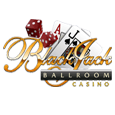Blackjack
Blackjack is a card game played with several decks, commonly four, six or eight. Standard 52-decks are used. It is based on the game of 21. Rules may vary slightly through each Microgaming Casino, so always check them before playing.
The History of Blackjack
Playing cards were probably invented in China. The earliest cards were domino cards that represented the scores thrown by a pair of dice, in similar way to dominos tiles. Chinese money cards evolved into modern playing cares. They has four that included coins, strings of coins, myriad strings and tens oh myriad of strings.
Playing Cards, similar to those used today, arrived in Europe in the 1370's. They originally has 52-card decks and suits of swords polo sticks, cups, and coins. Each suit had the numbers 1 to 10 and three court cards, which the Europeans changed into knights. There were many design changes. The symbols on the cards varied with different cultures. The suits of hearts, spades, diamonds and clubs come from French cards and have continued to be used in the present day.
Blackjack is derived from the game of 21. It was not very popular when it was first introduced to American Casinos. To increase interest, odds of ten to one were offered for a hand comprising an ace and one of the blackjacks, giving the game the name blackjack. The game became popular when researches found that it was possible to overcome the casinos advantage by using a basic strategy. The basic strategy was developed from computer simulation of the game to find the best moves to make depending on the cards dealt.
Card Values
Each card in the deck is assigned a value, number cards 2-9 are face value, jacks, queens, and kings are worth 10 points, aces are worth either a 1 or an 11. If you choose to use the ace as an 11, the hand is considered soft, its considered hard if you choose to use it as a 1.
Blackjack Actions
Hit: You re asking the dealer to give you another card. Your may hit as many times as you would like without going over 21. If you go over 21 this is called a bust and you lose.
Stand: You like the cards you are holding, and you want to stay with what you've got.
Double Down: You want to double your bet for a one-card hit. After you've received this card, you can not hit again.
Split: This allows you to divide a pair of like cards into two different hands. Depending upon which table you're on, you may re-split should you receive another like card. Also, on some tables you may double down after receiving a second card to your split hands. Generally, split Aces automatically receive only a second card and no further options will be presented.
Surrender: You want to forfeit your hand because you feel that the dealer will beat you (e.g. you've got 15 and the dealer is showing an Ace or a 10). By surrendering, you only lose half your bet. You must surrender when holding two cards. After a hit, this option will not be available.
Insurance: You want to insure your hand against the possibility of losing if the dealer gets a Blackjack. In order to buy insurance, you must pay an additional 50% of your bet and the dealer must show an Ace. Should the dealer get Blackjack, you'll lose your bet but your insurance will pay 2 to 1. Therefore, you'll get your money back. Payout's - Any winning hand pays 1 to 1
- Blackjack pays 3 to 2 (Depending on table rules)
- Insurance pays 2 to 1 (Depending on table rules)
Hit or Stand
Start with the basics: Always stand on a hand of 17 or more (excluding soft hands) as a strong hand in Blackjack is any hand of 17+. Above 16, your chances of improving are too small to risk busting, regardless of the dealer's up card. On the flip side, a player can never bust with a hand of 11 or less, so there is always a play to be made. Always hit a hand value of 8 or less. We will discuss 9,10, and 11 in more detail in the lesson on doubling down.
Dealer's Card is an Ace: This is the worst scenario on the table so lets start here.
One thing to consider in Blackjack is that a card with value 10 (10, Jack, Queen, King) is more likely than any other single card value (A through 9). In this case, the dealer has a Blackjack roughly 4/13. Also, the Ace gives the dealer more opportunities to draw cards without busting. The strategy here is to be aggressive and try and get a good hand (17+) as the dealer is likely to have a strong hand. Don't worry about busting and you should hit 16 or less, stand 17+.
When the Dealer's Card is a 10, J, Q, or K: There is still a 1 in 13 chance the dealer has a blackjack and a 4-in-13 chance of a 20 so a strong hand is required to compete. An 11 gives you a good chance of making a 21 with a hit so we will change our strategy slightly. You still need to risk busting and you should hit 10 or less, hit 12-16 and stand 17+.
When the Dealer's Card is a 7, 8 or 9: Now we have a better chance, as the dealer cannot make a Blackjack. However, it is likely that the dealer will make a strong hand of 17+ so again we must look for a strong hand to compete. However, now both 10 and 11 give you an excellent chance of a winning 20 or 21 so we adjust the strategy slightly again. You will still need to risk busting and you should hit 9 or less, hit 12-16 and stand 17+.
When the Dealer's Card is a 4, 5 or 6: Now we have the dealer in the worst possible position where a bust is very likely. The key is to NEVER bust in this situation and to increase your wager (double down) when prudent (9, 10, or 11). You should hit 8 or less and stand 12+. When the Dealer's Card is a 3: the dealer is still in a bad position where a bust is very strong possibility. However, there is a slight advantage to taking a card when you have a 12 even though a bust will occur in 4-of-13 times. You still want to increase your wager (double down) when prudent (9, 10, or 11) and so you should hit 8 or less, hit 12 and stand 13+.
When the Dealer's Card is a 2: The dealer is still in a bad position but a bust is slightly less likely because the chances of the dealer getting 2 cards totaling 20 is only roughly 10%. As such we will now hit on a 9 instead of doubling so you should hit 9 or less, hit 12 and stand 13+.
Following just these basic rules and put the odds in your favor, not the casinos.
Here is a helpful chart to follow when playing. Your cards are to the left, and the dealers cards are to the right.
Hard Totals
H = Hit S = Stand D = Double P = Split
| Hard Totals |
2 |
3 |
4 |
5 |
6 |
7 |
8 |
9 |
T |
A |
| 8 |
H |
H |
H |
D |
D |
H |
H |
H |
H |
H |
| 9 |
D |
D |
D |
D |
D |
H |
H |
H |
H |
H |
| 10 |
D |
D |
D |
D |
D |
D |
D |
D |
H |
H |
| 11 |
D |
D |
D |
D |
D |
D |
D |
D |
D |
D |
| 12 |
H |
H |
S |
S |
S |
H |
H |
H |
H |
H |
| 13 |
S |
S |
S |
S |
S |
H |
H |
H |
H |
H |
| 14 |
S |
S |
S |
S |
S |
H |
H |
H |
H |
H |
| 15 |
S |
S |
S |
S |
S |
H |
H |
H |
H |
H |
| 16 |
S |
S |
S |
S |
S |
H |
H |
H |
H |
H |
| 17-20 |
S |
S |
S |
S |
S |
S |
S |
S |
S |
S |
| Soft Totals |
2 |
3 |
4 |
5 |
6 |
7 |
8 |
9 |
T |
A |
| A2 |
H |
H |
D |
D |
D |
H |
H |
H |
H |
H |
| A3 |
H |
H |
D |
D |
D |
H |
H |
H |
H |
H |
| A4 |
H |
H |
D |
D |
D |
H |
H |
H |
H |
H |
| A5 |
H |
H |
D |
D |
D |
H |
H |
H |
H |
H |
| A6 |
D |
D |
D |
D |
D |
H |
H |
H |
H |
H |
| A7 |
S |
D |
D |
D |
D |
S |
S |
H |
H |
H |
| A8 |
S |
S |
S |
S |
D |
S |
S |
S |
S |
S |
| A9 |
S |
S |
S |
S |
S |
S |
S |
S |
S |
S |
PAIR SPLITTING
H = Hit S = Stand D = Double P = Split
| Pairs |
2 |
3 |
4 |
5 |
6 |
7 |
8 |
9 |
T |
A |
| 2 2 |
H |
P |
P |
P |
P |
P |
H |
H |
H |
H |
| 3 3 |
H |
P |
P |
P |
P |
P |
H |
H |
H |
H |
| 4 4 |
H |
H |
H |
D |
D |
H |
H |
H |
H |
H |
| 5 5 |
D |
D |
D |
D |
D |
D |
D |
D |
H |
H |
| 6 6 |
P |
P |
P |
P |
P |
H |
H |
H |
H |
H |
| 7 7 |
P |
P |
P |
P |
P |
P |
H |
H |
H |
H |
| 8 8 |
P |
P |
P |
P |
P |
P |
P |
P |
S |
P |
| 9 9 |
P |
P |
P |
P |
P |
S |
P |
P |
S |
S |
| 10's |
S |
S |
S |
S |
S |
S |
S |
S |
S |
S |
| A's |
P |
P |
P |
P |
P |
P |
P |
P |
P |
P |







